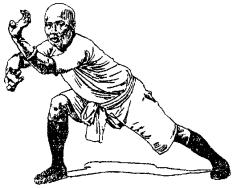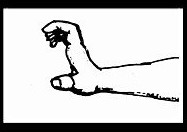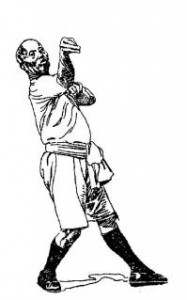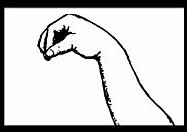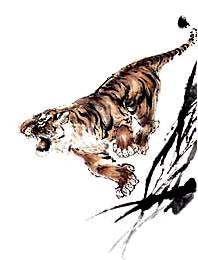 The Spirit of Tiger & Crane
The Spirit of Tiger & Crane
Learn the deadly combination of strategy and attitude
By Stefan Verstappen
Originally published in Black Belt Magazine April 03
Chinese animal styles are noted for their flamboyant forms and colorful origins but are Black Tiger or White Crane masters expected to growl and flap their arms? Or is there some other reason so many martial arts styles are based on animals?
“The five elements and their associated heraldic animals represent an ancient knowledge of how heavenly forces could be manipulated to affect earthly destinies. The central ritual of Taoist magic consists in the ability to call up the forces of these Spirit-Generals and indicates that the heraldic Animals are indeed the essence of supernatural powers.”
The Chinese PauKua, Ong Hean-Tatt,
Popular opinion holds that combat systems named after either real or mythical animals are patterned on the movements of the patron animal. The tiger style would copy the tiger’s raking claws, the crane style would imitate the bird’s pecking and poking actions, the snake would embody coiling and striking techniques, and so on. While some techniques do resemble the patron animal, most do not. So why name the style after an animal to begin with?
One theory is that each style embodies the animal’s behavior characteristics, or personality. Like a Shaman who Dances the Spirit of his guardian animal, each style has a distinct personality that is imitated to add energy to the fighting movements. The Tiger is strong and fearless hence the fighting style emphasizes confidence and strong powerful movements. The Crane is somber and elusive, hence the style uses a detached attitude and quick deceptive movements. In addition, each animal embodies a specific combat strategy, the Tiger is direct, the Crane is evasive.
Combining a pre-rehearsed strategy, with a conditioned emotional response, provides the best tool for survival – a plan.
In any emergency, it is essential to have a plan. Not having a plan makes panic more likely and panic makes all else useless. The shock of a violent attack has made even seasoned black belts forget their training. By embodying the attitude and strategy of your patron animal, you know what you’re going to do, and exactly how you’re going to do it.
The following examines the attitude and strategy of the Tiger and the Crane styles. These principles are universal and can be applied to any form of martial arts. According to tradition, each person will find he has an affinity for one of the animals, and will adopt that style in training and combat. When you read the following, ask yourself which animal personality and approach suites your personality. Then it is just a matter of applying those principles into your training and sparring routine.
When two tigers fight, one will die, but the other will be crippled.
Chinese Saying
Attitude
The tiger has no natural predators and, therefore, knows no fear. He is unpredictable and quick to anger, and when attacking is sudden and brutal. The attitude is that of fearlessness, and fierceness. Mentally, one must cultivate an attitude of indestructibility, courage, and disdain for discomfort. Greet obstacles with delight for giving you the chance to exercise your powers.
Strategy
Tiger style’s combat strategy is to destroy the opponent with a relentless and unrestrained attack. This is a powerful method designed to shock the opponent into fear and panic. When used by a large and healthy human, it is almost unstoppable. When both opponents use the same strategy, however, the result is disaster with both sides suffering serious injuries.
Historical examples of this strategy can be found with Viking Berserkers, (literally “those who wear bear skins”). The Berserkers wore the skins of wolves or bears and, in Shamanic fashion, would call on the powers of the animal spirit to infuse them with energy before battle. Working themselves into frenzy, they would charge naked into the enemy lines swinging their broad swords oblivious to any wounds received in return, hence the expression “to go berserk”. However, there is a dark side. The feeling of power tends to lead to cruelty and ruthlessness. Those that practice this method must be careful the beast does not escape from its cage.
Training Principles
Physical training includes weight and conditioning training aimed at increasing strength and mass. When sparring, sink your stance low and become aware of your mass as it pushes against the earth. Feel as though your body density has increased, no longer flesh and bones but wood and steel. When you stand still; you are a mountain, when you move; you are like an avalanche destroying everything in your path.
Flexing Your Claws
Flexing your claws is done by extending and contracting the fingers of both hands using dynamic tension while imagining your arms and hands being infused with energy. This is an excellent training method to improve finger and gripping strength. Flexing the claws can also act as a conditioned stimulus. When flexing your claws you imagine strength and energy flowing through your body. By associating strength and energy popular drug world with the finger exercise, you will be able to trigger this feeling whenever you form the Tiger claw
Method. Stand in a quite area and relax. Extend your arms and fingers out at shoulder height as though reaching out to grasp someone by the shoulders. Then, while breathing in, slowly turn the palms up and curl the fingers into tight fists and retract the arms using dynamic tension, as though pulling a great weight. As you perform the physical movements use the following imagery. When inhaling, imagine energy being drawn into your body through the nostrils, as well as up from the earth through your feet and legs. As you exhale, imagine the energy pulsating through your body and radiating outwards through the forearms and palms. Practice the method twice a day for several months, then, whenever faced with a difficult situation, flex your claws for a boost of confidence.
The tiger claw hand is formed by curling the fingers and bending back the wrist. You should feel a contraction of the extensor carpi muscles in the forearm and tiredness after holding the position for only a few minutes. Remember to tuck the thumb against the ridge and out of the way. In application, the heel of the palm is used in either a thrusting, or slashing motion, often followed by a clawing and grabbing action with the fingers.
Tire them by flight, cause division among them.
Sun Tzu, The Art of War
Attitude
The crane is the antithesis to the tiger. The crane tends to be nervous and flighty, but when strolling unmolested through the rice fields appears somber and regal. The emotion traditionally associated with the crane is an aloof awareness. Crane stylists must cultivate an attitude of calm, wariness, while always prepared to move and counter-strike quickly.
Strategy
The perfect counter to the Tiger’s aggressive onslaught is the strategy of the crane – to retreat and evade until the attack has lost its momentum, then launch a counter attack to exposed targets. The crane maintains a constant watchfulness to successfully evade the initial attack, waiting and watching for the opportunity to attack a weakness.
Technically, the crane strategy is more advanced than the tiger’s. One must remain relaxed and fluid in order to evade the initial attack, counter-strikes must be precise and unexpected, plus it requires a great degree of self-composure and awareness to be able to see and recognize the moment when the attacker is weakest. In modern times this strategy forms the basis of guerrilla warfare, and is summed up by Sun Tzu; “Evade what is strong, attack what is weak.” There is one weakness to this strategy, the tendency to become reactive. Ideally, one should move in sync with the attack, always staying one step ahead. However, if caught off guard, then instead of anticipating the attack, the defender can only react to the attack. Eventually reactions lose out to initiative.
Training Principles
Training should focus on awareness, mobility, speed, and deceptive evasions. Running, skipping, jumping are excellent exercises. When sparring, practice evading and absorbing attacks. Learn to stay just outside of critical range enticing the attacker into exhausting himself with techniques that fall short. When you are able to make yourself virtually untouchable, counter strikes become a matter of opportunity. When you stand still you are supple as water, when you move you are swift as the wind
Beating the Broom. Using a padded stick three or four feet long, have a partner thrust the stick at you from different angles while continuously moving towards you. Evade the attack by turning and moving the body out of the way, use the hands or arms only as a last resort to prevent being struck. Increase the difficulty of the exercise by allowing the partner to use swinging and thrusting actions together at random. Increase the difficulty even further by using two or more partners to attack simultaneously.
Crane Hand Formation. There are several hand formations associated with the crane beak. One method uses the four fingers to press against the thumb and uses the cluster of fingertips as the striking surface. Another uses just the first two fingers pressed against the thumb, and yet another extends just the first two fingers similar to a Boy Scout salute.
Conclusion
The Tiger, Crane, and Dragon are but a few styles whose forms and techniques occasionally resemble moves indicative of their namesake. However, did the ancient founders intend their legacy to be merely a graceful pantomime or was there more to it? Perhaps Myamoto Mussashi revealed the answer when he wrote. “In a contest where the opponents are equally matched in strength and technique, then it is the one with the greatest spirit who will win.
References
Ong Hean-Tatt, The Chinese PauKua, An Expose, Pelanduk Pub, Malaysia, 1991
Sun Tzu, Roger T. Ames Translator, The Art of War, Ballantine Books, New York, 1993,
Musashi, Miyamoto, The Book Of Five Rings, Bantam Books, New York, 1982
